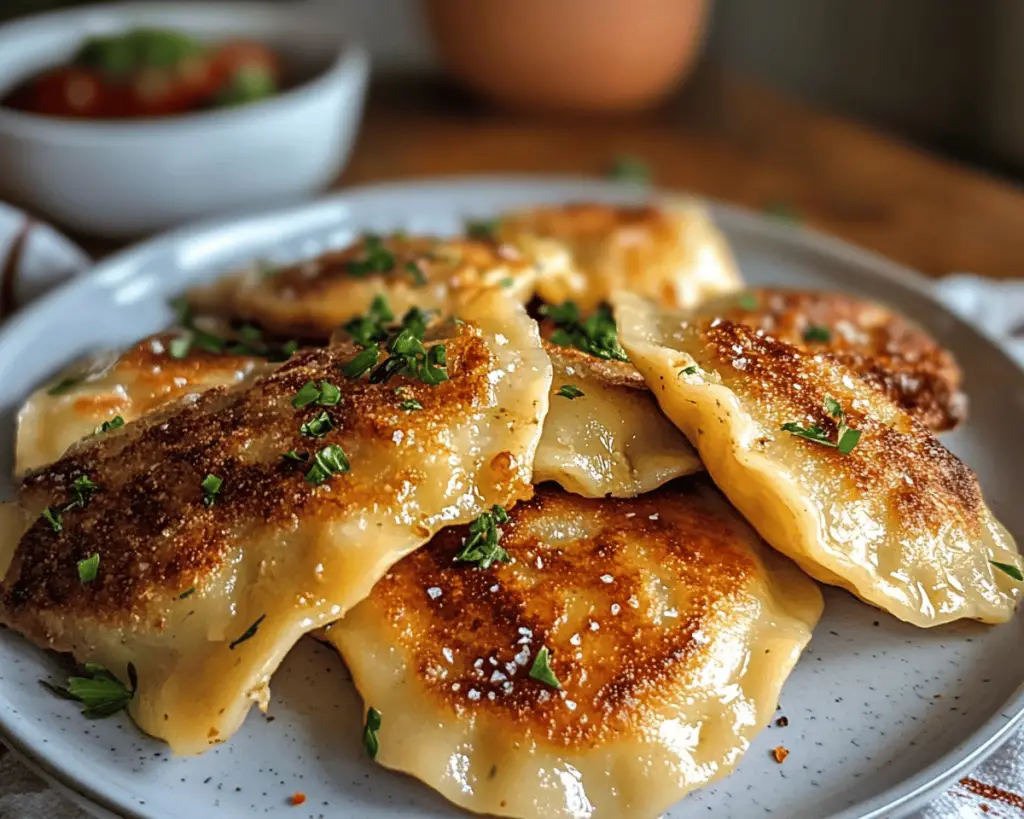Growing up in a household where the clock was always set to the rhythm of family meals, I found myself deeply entwined with the art of making pierogi—a delightful dish that has become a cherished cornerstone of my culinary repertoire. My grandmother, with her gentle hands and unwavering patience, was my mentor in this ethereal world of dough and fillings. Pierogi, especially those stuffed with luscious potato and cheese, whisk me back to warm summer evenings, bustling kitchens filled with laughter, and the harried sounds of family gathered ‘round the dinner table.
The first time I rolled out the dough was a moment of tentative excitement mixed with anticipation. “It’s like a cozy blanket for the filling,” Grandma would say, her eyes twinkling as she demonstrated the right thickness—just enough to hold but not conceal the treasure within. Those potato pierogi have a way of embracing you, of transporting you to a place steeped in tradition, memories, and love.
As I began to form those small half-moons, I realized that each pierogi was not just a simple dumpling; it was a vessel for stories—of my ancestors who brought this recipe from Eastern Europe and of future generations who would continue to relish them. Even now, each step of the process signals a generational passage, a continuity of love through food. Homemade pierogi aren’t just dinner; they’re seasonal celebrations, reminders of heritage, and an invitation to gather.
So, let me share with you my tried-and-true recipe for making potato pierogi, a dish that encompasses the spirit of family gatherings and comfort food. With each stage, I’ll guide you through the ingredients, the process, and even some lessons to make your own journey into the world of pierogi as heartwarming as mine.
Inside the Ingredients of Potato Pierogi
Let’s take a closer look at the ingredients that come together to create this traditional dish. Their simplicity belies the depth of flavor they provide, as well as their cultural significance.
Potatoes: The heart of these pierogi, the potatoes bring a creamy richness to the filling. I prefer using Yukon Gold potatoes for their buttery texture and flavor. When selecting your potatoes, look for those that are firm and smooth. If you’re feeling adventurous, try mixing in some sweet potatoes for a unique twist. The key is to cook them until tender, then mash them until smooth. Beware of using too much water when boiling, as you want your filling to be thick and hearty, not runny.
Onion: A finely diced onion plays a fundamental role in enriching the filling. Sautéed until golden and sweet, it adds a wonderful depth that complements the potatoes beautifully. I often find myself getting lost in the aroma as the onion caramelizes—it’s the scent of home. For a twist, consider swapping in shallots or leeks if you want a more delicate flavor.
Cottage Cheese: Traditionally, many recipes call for farmer’s cheese, but I find that cottage cheese works beautifully, yielding a satisfying creamy texture. It adds a slight tang that balances the earthiness of the potatoes. Be sure to use the small-curd variety; it gives a nice creaminess without overwhelming the other flavors. If you’re feeling adventurous, a sprinkle of grated cheddar in the filling can elevate the taste even further.
Flour: All-purpose flour serves as the foundation for the dough, binding everything together. When mixing the flour with water and salt, treat it gently. Pierogi dough should be smooth yet resilient, a balance of elasticity allowing them to hold their shape without tearing. If you want to amp up the nutrition factor, consider using whole wheat flour or even spelt flour; you’ll get a slightly nuttier flavor while keeping the pierogi soft.
Eggs: While some recipes skip eggs entirely, including one yolk in the dough gives it richness and structure. If you’re looking to keep the recipe vegan, simply replace the egg with a tablespoon of vinegar or aquafaba; it helps create a light texture.
Salt: A pinch of salt heightens the flavors, both in the dough and in the filling. Don’t skimp on this; it’s a character player in the overall taste of the pierogi.
Butter: For frying the pierogi (or simply for serving!) melted butter is a must. I often infuse it with fresh herbs like dill or parsley, bringing an additional layer of flavor. If you want to keep it vegetarian, olive oil is a fantastic alternative for frying with a hint of richness.
Sour Cream: Traditionally served as a dip or topping, sour cream adds a nice tangy note that contrasts beautifully with the savory filling. I often add chives into my sour cream for an extra touch of flavor that breathes freshness into the dish.
How Potato Pierogi Fits Into a Balanced Life
When it comes to nutrition, potato pierogi might not spring to mind when you think about your healthiest meal options. However, they can certainly fit into a balanced lifestyle when prepared thoughtfully. Each ingredient contributes to a wholesome dish that speaks to nourishment in both body and spirit.
The combination of potatoes and cottage cheese provides a good source of complex carbohydrates and protein, making the filling not only satisfying but also energizing. Potatoes deliver essential vitamins and minerals, particularly Vitamin C and potassium, while cottage cheese adds beneficial probiotics and calcium.
Onions, often overlooked, are rich in antioxidants and have anti-inflammatory effects. The fiber content in the dough and potatoes helps with digestion, making pierogi a fulfilling meal without the heaviness associated with too many refined carbohydrates.
That said, I also believe in the joy of balance. Eating is a sensory experience, one that involves not only fueling our bodies but also nourishing our souls. I can still recall the laughter and stories shared with family at the table, all centered around these simple dumplings. It’s essential to indulge in these traditions and enjoy the process of cooking and eating. By incorporating seasonal vegetables or a fresh salad on the side, I find joy in blending comfort with nutritious choices.
What You’ll Need
For approximately 4 servings of delicious potato pierogi, gather the following ingredients:
– 2 cups all-purpose flour
– 1 large egg (or 1 tablespoon vinegar/aquafaba for a vegan option)
– 1/2 teaspoon salt
– 1/4 cup water (add more if necessary)
– 2 cups Yukon Gold potatoes, peeled and cubed
– 1 cup small-curd cottage cheese
– 1 medium onion, finely diced
– 2 tablespoons unsalted butter (for sautéing)
– Salt and pepper to taste
– Additional butter for frying or drizzling (optional)
– Sour cream and fresh herbs for serving
Preparing Potato Pierogi Step by Step
1. **Make the Dough:** In a large mixing bowl, combine the flour and salt. Create a well in the center and add the egg (or your chosen replacement). Slowly add the water while mixing with your other hand until the dough comes together. If it feels too sticky, add a touch more flour—if too dry, add a bit more water. Knead gently until smooth, cover with a clean towel, and set aside to rest for about 30 minutes.
2. **Prepare the Filling:** While the dough rests, boil your potatoes in salted water until fork-tender, about 15-20 minutes. Drain the potatoes, allow them to cool slightly, then mash until smooth. In a skillet, melt the butter over medium heat. Add the finely diced onion and sauté until translucent and golden, about 5-7 minutes. Combine the mashed potatoes, cottage cheese, and sautéed onions in a bowl, adding salt and pepper to taste. Set aside to cool completely.
3. **Roll the Dough:** After resting, divide the dough into four equal parts. On a floured surface, roll out one piece into a thin sheet, about 1/8 inch thick. Use a round cutter (or the rim of a glass) to cut out circles, about 3-4 inches in diameter. Make sure to re-flour your surface as needed to prevent sticking.
4. **Fill the Pierogi:** Place a small spoonful of the filling (about 1 tablespoon) onto the center of each circle. Be careful not to overfill—this can lead to bursting during cooking. Fold the dough over the filling to create a half-moon shape, and pinch the edges to seal. Crimp the edges with a fork for a decorative touch.
5. **Boil the Pierogi:** Bring a large pot of salted water to a gentle boil. Cook the pierogi in batches—add only enough to not overcrowd the pot. Once they float to the top, let them cook for an additional 2-3 minutes. Use a slotted spoon to remove them and place them on a clean kitchen towel to drain.
6. **Fry (optional):** For a delicious finish, heat melted butter in a skillet over medium heat. Fry the boiled pierogi until golden and crispy on each side, about 3-4 minutes. Serve piping hot!
7. **Serve:** Plate with a generous dollop of sour cream and a sprinkle of fresh herbs like parsley or chives. Enjoy the warmth of a dish filled with history and flavor.
Lessons from My Kitchen
Over the years of making these delightful potato-filled dumplings, I’ve learned quite a few lessons that have helped shape my approach to cooking and entertaining. At first, I was far too perfectionistic. My pierogi were either too thick or my seals broke open in the boiling water, creating a kitchen disaster. I realized that the charm of pierogi lies in their handmade nature—each one is unique, much like the experiences shared around the table.
Another eye-opening discovery was the beauty of experimentation. While the classic potato and cheese filling is renowned, I’ve enjoyed introducing seasonal vegetables into the mix. Spinach, mushrooms, or even beets have found their way into my filling, lending not just seasonality but also bursts of vibrant color.
And let me not forget the worth of collaboration. My kids love to get involved in the pierogi-making process, whether it’s rolling the dough or pinching the edges. It smoothly transitions from only a cooking task to a cherished family activity. Food has a way of building not just a meal but a collective memory, something to carry forth. I invite you, too, to draw in your loved ones, share in the laughter, and let cooking become a bridge between generations.
As seasons change, so do the flavors. I often find that crafting potato pierogi in winter is a way to wrap up this comforting style of cooking in a blanket of warmth, while spring pierogi might evoke new vegetables from local farmers’ markets. Each whiff of fried pierogi takes me back to Grandma’s kitchen, a thread stitching together our family’s fabric.
I also embrace the challenges that come with homemade pierogi. Mistakes are bound to happen, whether the filling spills out or a hole tears in the thin dough. I’ve learned that not all experiences in the kitchen go according to plan— and that’s perfectly okay. Each “imperfection” leads to lessons learned and often, a delicious story to share.
In closing, I gently encourage you to try out this potato pierogi recipe in your kitchen and see how it weaves into your own family traditions. Cooking is more than just a process; it’s a tapestry of flavors, memories, and moments that connect us to each other. So gather your loved ones, roll up your sleeves, and allow yourself to be swept away by the joy that comes with each handmade dumpling. Every bite will carry the soul of your efforts, adding to the comforting, eternal dance of food and family that defines who we are.



